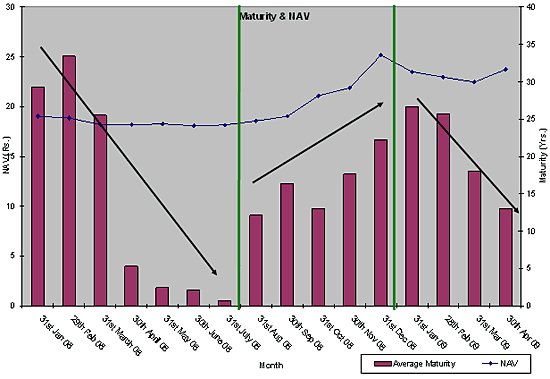
A look at the chart alongside highlights the following points:
Please read all the articles given below in this series to get fully, a grasp of what we are discussing in this article and also in the ones following this.
Understanding debt market basics: I
Understanding debt market basics: II
Understanding debt market basics: III
Understanding debt market basics: IV
Understanding debt market basics: V
The gist of all the articles above is that 'nobody loves your money more than you do' and hence, the only way to make your money grow is by understanding the language of money. Far from being difficult, the language of money is addictive! Read on...

Having appreciated that we need to keep an eye on interest rates for investing in bonds the next question is how do we know when rates are expected to fall/ rise?
You don't even need to read the business newspapers for this. Even in general dailies you will get talking heads making statements about the need for interest rates to go up/ down.
Like in the current scenario, there are many (including 'yours truly') who believe that interest rates have come down as much as they could have and should have (by interest rates we mean CRR, repo, reverse repo which have been explained in one of the previous articles) and hence going forward, the probability of interest rates moving southwards from here, is very little.
Since October 2008 the RBI has aggressively cut the above-mentioned policy rates. By this what has happened is that banks have lot of money with them (see reverse repo explanation in the previous articles).
By reducing these rates, it is anticipated that banks will lower rates on FDs. High interest rates on FDs are good for us but for the bank they represent a higher interest outgo. So when RBI cuts key rates, banks will in all likelihood reduce FD rates, thereby reducing the cost of garnering these deposits for the banks. Hence banks can pass loans to borrowers at lower interest rates.

Now if we know that banks have a lot of money, then obviously RBI would like them to lend the money to borrowers rather than keep it with themselves (or depositing it with RBI). Had the banks given away all the money to borrowers and then faced a liquidity problem, the RBI may have reduced interest rates even more. But that does not seem to be the case. So chances are that we are at the bottom of the interest rate cycle or very near to the bottom (read: interest rates are likely to move upwards from here).
This logic also explains (partly) why the NAV of the scheme shown in Table 1 is sliding since January 2009. So going back to the basics we now know that this is definitely not the time to invest in long-term bond funds.
Also an empirical way of knowing when interest rates have bottomed or are nearing the bottom is when we start getting calls from banks for taking loans in general and 'personal loans' in particular.
When banks have a lot of cash, they want to disburse it ASAP and at as high rates as possible. Thus they start making offers to us.
Obviously there is more supply of money than demand and hence money is available cheap (that is low interest rates for us!). Personal loans are the riskiest from the bank's point of view and hence they charge a very high rate of interest on them. What will happen as more and more people (individuals and corporates) start taking loans from the banks?
The demand for money will start going up and the supply will start reducing resulting in higher cost of money for us. Thus rising interest rates!

Now neither am I an economist, nor do you need to be one to make the above observation (in fact we all observe these things, all we need to do is to just try to ask why is the bank doing this. That is, read from the indicators. We surely do not need any professional help to ask questions!); however equally true is the fact that 'Nobody loves my money more than i do' and hence when it comes to investment decisions, I would like to be in total control of my money. Even if I am handing over my money to professionals.
The decision has to be mine; it's only the implementation that is being outsourced. This is a critical differentiation from the investor's point of view. We go to the market only to buy vegetables. The vegetable vendor does not decide what we should cook. He is there only to give us what we want! If we start asking the vendor what vegetable should we buy everyday he may tell us to buy only one vegetable: the one where his margins are highest!
As we love our money, he has all the right to love his money!
Take a look at Table 1 and you will realise that this has what has actually happened. Investors relied upon some external source of information rather than interpreting signals themselves and ended up being the last ones to enter when the party was over!
So the only way to make money is to be in total control of our investment decisions. Gains are ours so are the losses, fair enough?
How do we remain in control of our finances? Read, read and once that is done then read some more. Only education can bail us out!
Till now we have understood what CRR, repo, reverse repo mean, how RBI uses monetary policy to control inflation and kick start economic growth, how fixed income securities are impacted by interest rates, how long term bonds behave in rising and falling interest rate scenarios and how we can anticipate interest rate movements by looking at very basic indicators.
Going forward we will keep focusing on small pieces of debt markets and economy so that we as retail investors become more independent and our investment decisions are better informed.